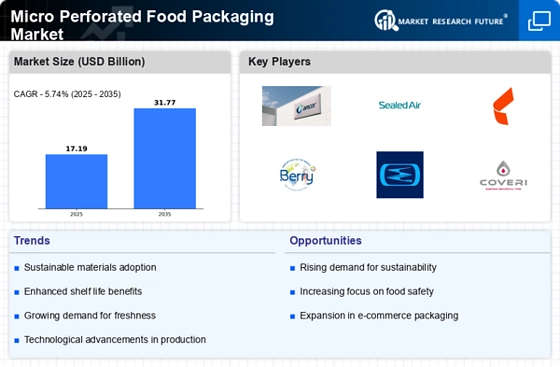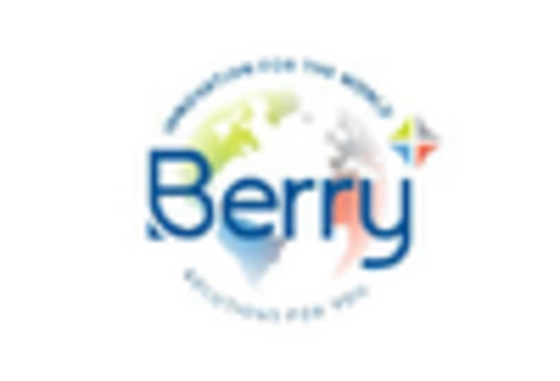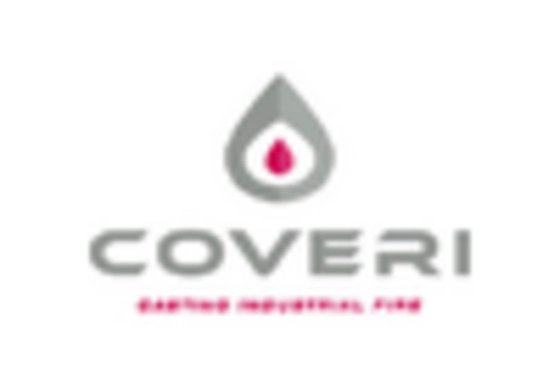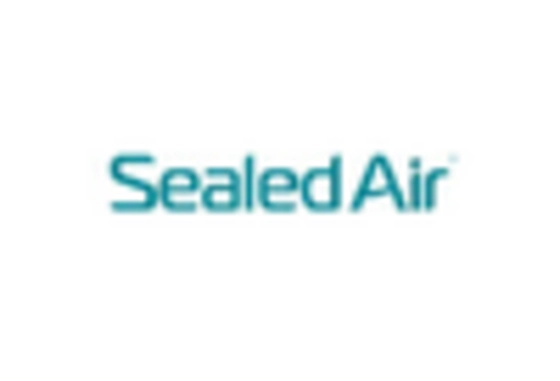Rising Demand for Fresh Produce
The increasing consumer preference for fresh and minimally processed food products is driving the Micro Perforated Food Packaging Market. As consumers become more health-conscious, they seek packaging solutions that extend the shelf life of fresh produce without compromising quality. Micro perforated films allow for optimal gas exchange, which is crucial for maintaining the freshness of fruits and vegetables. According to recent data, the demand for fresh produce packaging is projected to grow at a rate of 5% annually, indicating a robust market potential for micro perforated solutions. This trend is further supported by the growing retail sector, which increasingly emphasizes the importance of packaging in preserving food quality and reducing waste. Thus, the Micro Perforated Food Packaging Market is likely to benefit significantly from this rising demand.
E-commerce Growth in Food Sector
The rapid expansion of e-commerce platforms for food delivery is significantly influencing the Micro Perforated Food Packaging Market. As online grocery shopping becomes more prevalent, the need for effective packaging solutions that ensure product integrity during transit is paramount. Micro perforated packaging provides the necessary ventilation to prevent spoilage, making it an attractive option for e-commerce retailers. Recent statistics indicate that the online food delivery market is expected to grow by over 10% annually, creating a substantial opportunity for micro perforated packaging solutions. This growth is likely to encourage manufacturers to innovate and adapt their packaging strategies to meet the demands of e-commerce, thereby enhancing the overall market landscape for the Micro Perforated Food Packaging Market.
Consumer Awareness of Food Safety
The growing consumer awareness regarding food safety and quality is a crucial driver for the Micro Perforated Food Packaging Market. As consumers become more informed about the risks associated with food spoilage and contamination, they are increasingly seeking packaging solutions that ensure safety and freshness. Micro perforated packaging provides an effective barrier against external contaminants while allowing for necessary gas exchange, thus maintaining product integrity. Market Research Future indicates that the food safety packaging segment is expected to grow by approximately 8% annually, reflecting heightened consumer expectations. This trend compels manufacturers to prioritize safety features in their packaging solutions, thereby enhancing the appeal of the Micro Perforated Food Packaging Market.
Technological Innovations in Packaging
Technological advancements in packaging materials and processes are significantly shaping the Micro Perforated Food Packaging Market. Innovations such as improved film formulations and enhanced perforation techniques are enabling manufacturers to create more effective micro perforated solutions. These advancements allow for better control of moisture and gas exchange, which is essential for preserving food quality. Recent developments indicate that the market for advanced packaging technologies is projected to grow at a compound annual growth rate of 6%, highlighting the potential for micro perforated packaging to capture a larger market share. As companies invest in research and development, the Micro Perforated Food Packaging Market is likely to experience enhanced product offerings and increased competitiveness.
Sustainability and Eco-friendly Packaging
The increasing emphasis on sustainability and eco-friendly practices is a pivotal driver for the Micro Perforated Food Packaging Market. Consumers are becoming more aware of environmental issues, leading to a demand for packaging solutions that minimize waste and utilize recyclable materials. Micro perforated films can be produced from biodegradable materials, aligning with the growing trend towards sustainable packaging. Market analysis suggests that the eco-friendly packaging segment is expected to witness a growth rate of approximately 7% per year, reflecting a shift in consumer preferences. This trend not only supports environmental goals but also encourages companies to adopt innovative packaging solutions that meet regulatory standards. Consequently, the Micro Perforated Food Packaging Market stands to gain from this shift towards sustainability.

















Leave a Comment